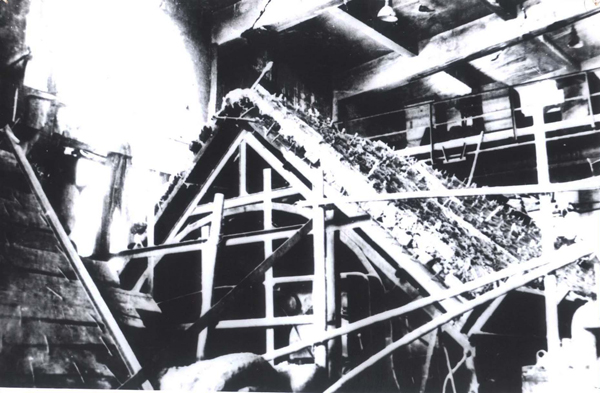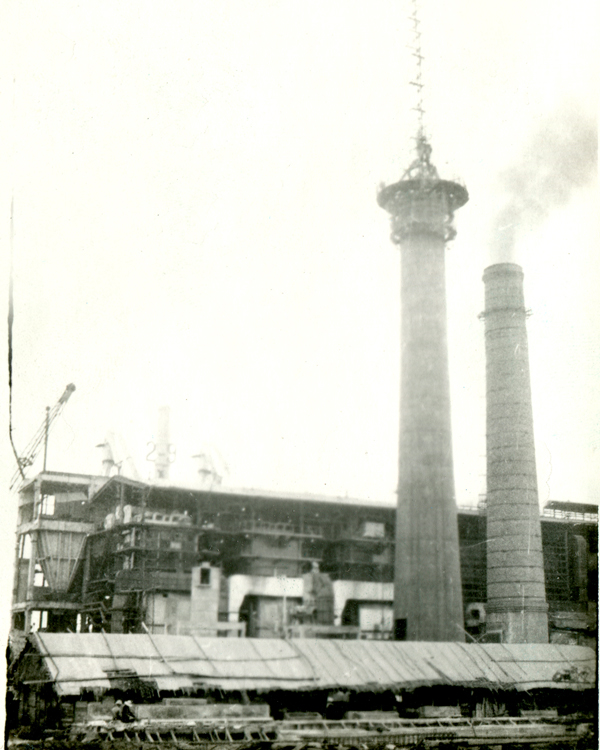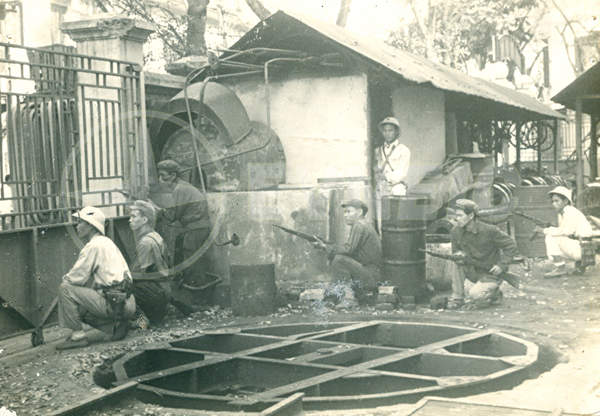Vinh Power Plant (Nghe An)
The Vinh Thermal Power Plant, with a capacity of 8,000kW, was constructed in June 1956 with technical assistance from the former Soviet Union. The plant went into operation in June 1958, supplying electricity to industry, agriculture, national defense, and the daily lives of the people in Nghe Tinh Province (now Nghe An and Ha Tinh provinces).
During its first years of operation (1959 - 1964), the plant served as a training ground for skilled technical workers both within and beyond the power sector, consistently leading the movement for safe operation across northern Vietnam. It consistently led the movement for safe operation across the power sector in northern Vietnam. Ten of its teams were recognized as Socialist Labor Teams. The Plant Collective was awarded the Second-Class Labor Medal.
In 1964, as the American Empire launched massive bombing campaigns against northern Vietnam, the Vinh Power Plant was severely damaged. For 10 years during the resistance war against the American Empire, the plant was one of the most heavily bombarded targets. Thirteen officials and workers heroically sacrificed their lives. American Empire aircraft attacked the plant more than 300 times, dropping approximately 2,319 bombs of various kinds, 149 missiles, and 64 artillery shells. The plant had to restore production 26 times. With the spirit of “fighting while producing, keeping the power running,” in January 1967, the plant was honored by the Party and the State with the title “Heroic Vinh Power Plant.”
In December 1967, the Department of Electricity decided to restructure the Vinh Power Plant to secure wartime power supply: maintaining Ben Thuy Thermal Power Plant, constructing the 3/2 Thermal Power Plant in Huyen Trung Cave, Anh Son District, and building diesel generator stations scattered across Nghe Tinh.
Due to the electricity shortage in Nghe Tinh, in early 1977, the Ministry of Electricity and Coal decided to dismantle the 3/2 Thermal Power Plant and transport it to Ben Thuy for installation, restoring the Vinh Power Plant’s capacity to 8,000kW as before.

Covering and protecting machinery and people at Vinh Power Plant (1966) - Photo: Tran Nguyen Hoi
On February 8, 1983, Vinh Power Plant was first connected to the national grid.
On August 13, 1984, the plant was renamed Nghe Tinh Power Department, tasked with: Producing and managing the power grid in Nghe Tinh territory from voltage level 110kV and below; Designing and constructing power lines and stations from 35kV and below; Receiving power from the grid and trading in electricity according to assigned tasks. This marked the transition from state-subsidized electricity production to grid management and commercial electricity distribution. Initially, the department faced challenges such as labor redundancies and staff skills mismatched with the new functions. Through tireless efforts, it gradually stabilized operations and served electricity users effectively.
In October 1985, Vinh Power Plant stopped operating due to increased power supply in the North (Pha Lai Thermal Power Plant connected to the grid). Thus, after nearly 30 years of generating electricity, Vinh Power Plant completed its historic mission.
In 1997, the plant was recognized as a National Historical and Cultural Site under Decision No. 423/QD-VH, dated February 20, 1997, issued by the Ministry of Culture.
Fully aware of its historical significance, Nghe An Power Company has preserved this landmark. In addition to keeping part of the former plant’s premises, Nghe An Power Company has also restored and maintained several original structures, including the smokestack, the Soviet-built boiler-turbine control center, the system of underground tunnels in Dung Quyet Mountain (D6 Cave), and many other artifacts now housed in the company’s Tradition Room.
Viet Tri Power Plant (Phu Tho)
Located in the Viet Tri Industrial Zone, Viet Tri Power Plant commenced construction in April 1959 on a 9,000m² site, comprising three generating units with a total capacity of 16MW.
At that time, Viet Tri Power Plant was the largest in the North, responsible for supplying electricity to the Viet Tri Industrial Park as well as to midland and mountainous provinces such as Phu Tho, Vinh Phuc, Tuyen Quang, and Ha Giang.
On 17 September 1959, Deputy Minister of Industry Ngo Minh Loan signed Decision No. 2198-BCN-TC, officially putting the plant into operation. Lieutenant Colonel Le Tan Trinh, Battalion Commander of Battalion 538, was appointed the plant’s first Director. The leadership and management staff are primarily comprised of military officers and political officers. About 50% of the plant’s production workers were former southern soldiers from Battalion 538, while the rest were transferred from the Lao Cai and Vinh power plants.
In 1961, Viet Tri Power Plant officially brought its first unit online, with a generating capacity of only about 3–4MW.
On March 18, 1962, the Viet Tri Industrial Zone was inaugurated. The plants within it began operations, leading to a significant increase in electricity demand. The plant had to operate three boilers and two generators simultaneously, sometimes mobilizing all three units.
Plant employees quickly adopted modern production technologies while strictly adhering to technical and safety procedures and regulations. Within two years, they were able to completely replace foreign experts and ensure the safe operation of the plant. “Power generation was considered a battlefield; workers were soldiers with industrial discipline and rigor.” With that spirit of dedication, in 1963, the Plant’s power output reached 63,576,000kWh. From 1961 to 1965, the plant generated 227,709,000kWh, contributing to the fulfillment of the State’s first Five-Year Plan.

Viet Tri Power Plant, 1978 – During expansion phase, boilers No. 7 and No. 8, along with a second 60-meter-high smokestack, were installed. Photo: Tran Nguyen Hoi.
The plant’s glorious history was marked not only by production achievements but also by the heroic sacrifices of its workers during the war against the American Empire.
From March 1967 to August 1972, thirteen staff members died while operating the plant. “The heart of an electrician may stop beating, but the current must never be cut off.” The selfless dedication of its staff enabled the Plant to stand firm amidst the flames of war and excellently fulfill its mission of supplying electricity to the North.
Following the Great Victory in Spring 1975, Viet Tri Power Plant reorganized production, stabilized its organizational structure, reinforced peacetime management procedures, and simultaneously overhauled, installed, and replaced old equipment, thereby boosting labor productivity.
From 1976 to 1980, pulverized coal technology was successively applied in the electricity production line.
From 1981 to 1986, Viet Tri Power Plant introduced many innovations in equipment and production, with machinery being repaired, overhauled, or replaced. The elevated boilers and furnace roofs helped reduce dust and noise, significantly improving the working environment for the plant’s staff and workers.
In 1986, as the power industry developed and many large-capacity power plants were commissioned, Electricity Company No. 1 decided to redefine the mission of Viet Tri Power Plant, shifting its role from operating boilers for power generation to supplying steam for the Industrial Park.
By 1992, factories in Viet Tri Industrial Park, such as the Paper Factory, Sugar Factory, and Chemical Factory, were able to generate their own steam, no longer relying on the Power Plant. Viet Tri Power Plant officially ceased operations in 1992.
After 32 years of construction and development, Viet Tri Power Plant has completed its historical mission, deserving the noble title of Hero of the People's Armed Forces during the anti-American period, awarded by the State in 2002.
Yen Phu Power Plant (Hanoi)
Construction of the Yen Phu Power Plant began in 1925 under French colonial rule. By 1932, the first phase was completed with four boilers. In the second phase, four additional boilers were installed, followed by two more in 1949 to expand capacity.
As one of the plants of the Indochina Electricity Company, Yen Phu Power Plant was, before 1960, the largest in northern Vietnam, playing a key role with a capacity of 22.5MW.
During the struggle for national liberation, Yen Phu Power Plant was regarded as a ‘repository of historical legends,’ tied to many events and feats associated with the Vietnamese working class movement.
In 1946, the whole country resisted. On the afternoon of December 19, 1946, workers at Yen Phu Power Plant were entrusted with a crucial mission: to cut off the power supply, signaling units to coordinate their actions in a precisely timed operation. The goal is not to damage the equipment, just to cut off the power to the entire city for a short time. At the same time, we had to ensure secrecy, accuracy, and certainty of victory. At exactly 8:30 p.m. on December 19, 1946, a loud explosion rang out, and the lights in Hanoi suddenly went out. The attack order was given, and all units opened fire simultaneously. The battle was fierce and fierce. Some of our comrades sacrificed themselves, but all of us still advanced with the oath " Determined to die so that the Fatherland may live".
In 1954, North Vietnam was completely liberated. Before taking over the capital, the Party and Government’s policy was that, upon takeover, the capital must have electricity, ensure safety, and meet the people’s needs for food, housing, electricity, and water. Workers at Yen Phu Power Plant and Bo Ho Lamp Plant fought fiercely, life and death, with the enemy to ensure the above goals.

Employees of Yen Phu Power Plant practice hand-to-hand combat with the enemy. (Hanoi, June 1966). Photo: Tran Nguyen Hoi
From 1961 to 1965, staff focused on power generation, economic recovery, and supporting long-term national development plans.
In 1966, American Empire planes bombed the North. By that time, the annual electricity output of Yen Phu Power Plant had reached hundreds of millions of kWh, approaching its design capacity, when the plant was suddenly and severely bombed by US forces. On May 19, 1967, American Empire aircraft began bombing the Plant. On May 21, 1967, American Empire aircraft bombed the Plant's boiler, severely damaging the Poland No. 14 boiler.
On June 10, 1967, American forces continued their attack, but a bomb failed to detonate and stayed perched on the roof of Boiler No. 2. The engineering force inspected the unexploded bomb and discovered a roll of film inside. It was a radio bomb. The plant’s military command concluded that a new battle of wits was necessary: to protect the target, deceive the enemy, camouflage the plant by building anti-aircraft walls around it, creating irregular shapes on the roof, and painting the plant and its surrounding area black. Chemical troops sprayed smoke when there was an alarm of incoming aircraft, making it difficult for American aircraft to detect the target and to drop bombs on the plant. At the same time, emergency slides for workers and staff were urgently constructed, enabling prompt evacuation whenever an alarm sounded.
On August 21, 1967, American aircraft carried out the fourth attack on the central area of the Plant, destroying the turbine roof and machine room. This attack caused heavy damage to the Plant.
On October 26, 1967, American aircraft launched their fifth fierce attack, putting immense pressure on the defenders. Plant workers and armed forces fought back to the end, shooting American aircraft into the plant's coal slag tank and capturing the pilot. On December 21, 1972, US aircraft continued to drop laser bombs on the plant, causing hundreds of tons of reinforced concrete to collapse. Two furnace operators were killed. The plant suffered damage to most of its equipment, machinery, and workshops. On December 27, 1972, the plant’s staff restored several boilers and promptly returned them to operation. By the end of the first quarter of 1973, the main equipment had been restored and put into production.
On 18 May 1996, Yen Phu Power Plant was awarded the title of Labor Hero. In 1984, due to the country’s need for large power sources to support economic development, the Plant changed its mission and was converted into a Compensation Generation Workshop. In 1988, Yen Phu Power Plant ceased operations after 63 years of both production and fighting, contributing to the protection of the Capital. On the site of the former Yen Phu Power Plant now stands a modern Twin Tower, serving as the headquarters of Vietnam Electricity and housing units of the power industry.
Translator: Hải Yến
Share